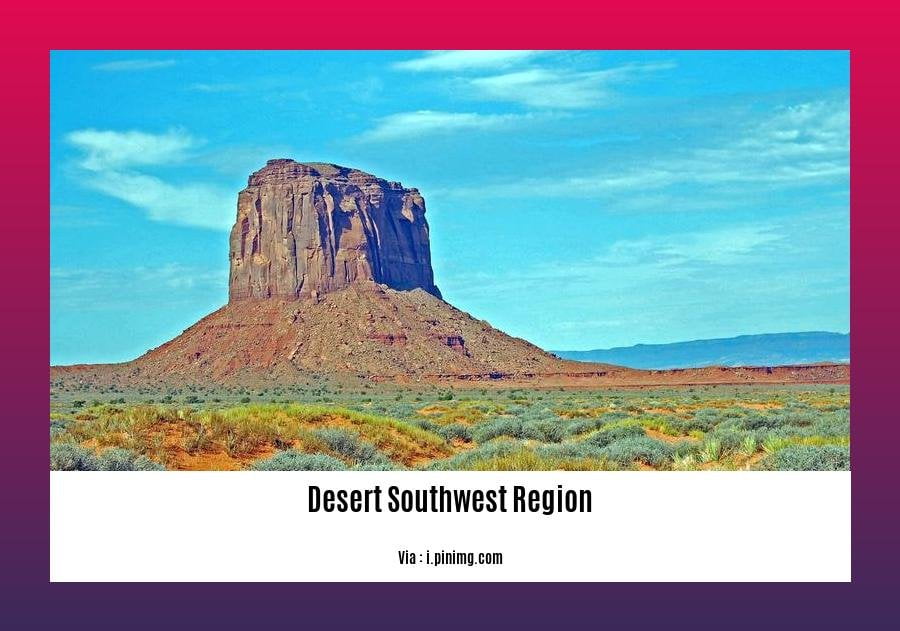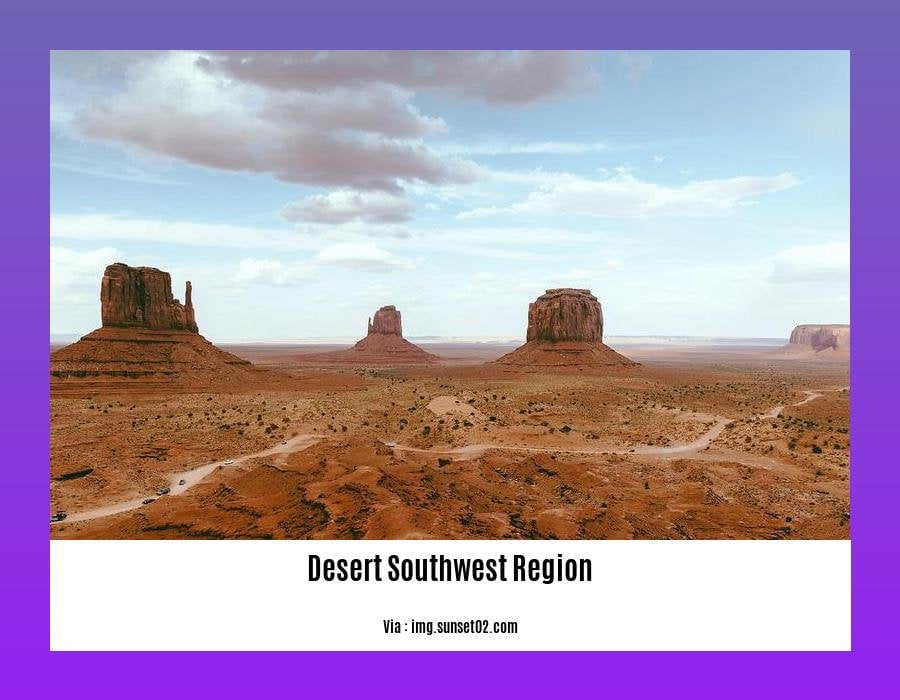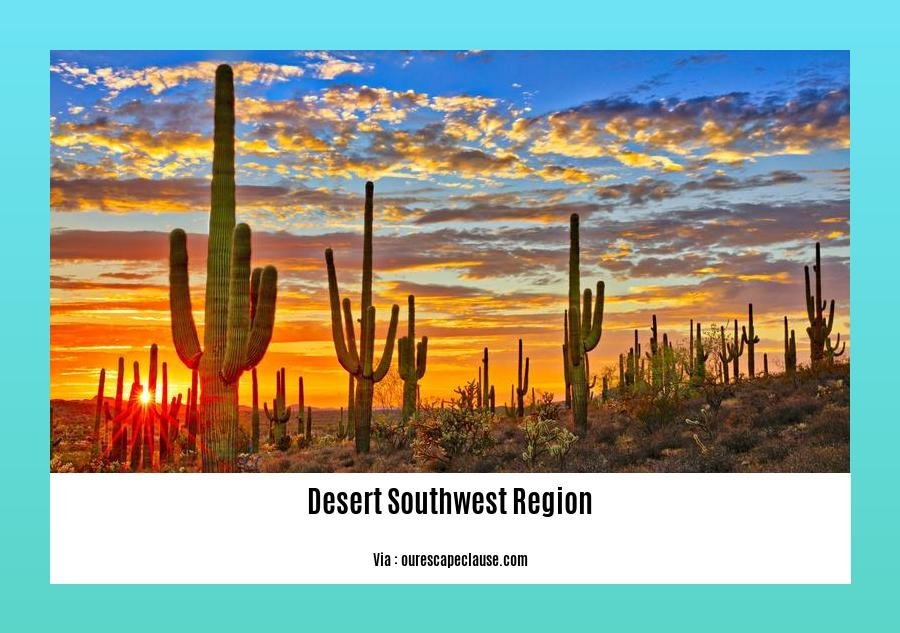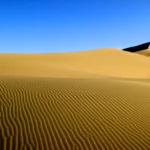Imagine exploring a mystical land where nature’s artistry meets the echoes of history. Buckle up for an adventure into the Desert Southwest, a place where awe-inspiring scenery, vibrant cultures, and captivating tales intertwine to create a breathtaking masterpiece. From the towering red rock giants of Sedona to the endless dunes of the Sonoran Desert, prepare to unlock the secrets and wonders of this enchanting region.

Facts About the Desert Southwest Region
Picture blazing sunsets, endless horizons, and a landscape painted with the most vibrant colors imaginable. That’s the Desert Southwest! This captivating region is more than just scorching heat and prickly cacti – it’s a fascinating blend of diverse ecosystems, rich cultures, and awe-inspiring natural wonders. Let’s uncover some intriguing facts about this mesmerizing corner of the US.
A Land of Extremes and Surprises
Spanning six states – Arizona, California, New Mexico, Texas, Nevada, and even reaching into Mexico – the Desert Southwest is a land of extremes. Imagine scorching deserts baking under the intense sun, contrasted with snow-capped mountain peaks reaching for the heavens. But within this land of contrasts lies an amazing array of life, all uniquely adapted to thrive in this challenging environment.
Take the Sonoran Desert, for instance. It’s home to the iconic saguaro cactus, a symbol of resilience with its ability to store water and withstand the harshest conditions. Then there’s the Chihuahuan Desert, the largest and hottest in North America. Don’t underestimate its stark beauty – it teems with life, from roadrunners darting through the underbrush to majestic pronghorn antelope gracefully navigating the plains.
Key Points about the Desert Southwest Region:
- Land of Extremes: Scorching deserts and snow-capped mountains coexist, creating diverse ecosystems.
- Home to Unique Flora and Fauna: Saguaro cacti, pronghorn antelopes, and roadrunners thrive in challenging environments.
A Tapestry Woven with Culture and History
The Desert Southwest is more than just a stunning landscape – it’s a place steeped in history and brimming with cultural richness. Native American tribes have called this land home for centuries, leaving an indelible mark on its identity. Their art, spirituality, and traditions are deeply intertwined with the land, offering a glimpse into the region’s ancient soul.
But the story doesn’t end there. Spanish explorers arrived, bringing their own vibrant culture, evident in the region’s architecture, music, and mouthwatering cuisine. Add Anglo settlers into the mix, and you have a true melting pot of cultures. From cowboy lore and ranching traditions to bustling cities with a modern edge, the Desert Southwest is a captivating blend of old and new.
Key Points about the Desert Southwest Region:
- Rich Cultural Heritage: Native American tribes, Spanish explorers, and Anglo settlers have influenced the region’s art, architecture, and cuisine.
Nature’s Masterpieces on Full Display
Prepare to be amazed by the sheer geological wonders that define the Desert Southwest. The Painted Desert of Arizona is a sight to behold – imagine a canvas painted by nature itself, with layers of colorful rock formations creating a mesmerizing spectacle. And speaking of mesmerizing, towering mountain ranges like the majestic Rocky Mountains and the rugged Sierra Nevada rise dramatically from the desert floor, offering breathtaking views and challenging hikes.
Then, there’s the Grand Canyon – a true testament to the power of nature. This immense chasm, carved by the relentless Colorado River, is a humbling reminder of the Earth’s immense scale and timeless beauty. Exploring its depths or simply gazing upon its grandeur is an experience that will stay with you forever.
Key Points about the Desert Southwest Region:
- Geological Wonders: Painted Desert, Rocky Mountains, Sierra Nevada, and Grand Canyon showcase nature’s power and beauty.
Adventure Awaits Around Every Corner
Whether you’re an experienced hiker or a casual nature enthusiast, the Desert Southwest has something for everyone. Lace up those hiking boots and explore scenic trails that wind through diverse landscapes. Discover hidden oases tucked away amidst towering red rock formations, or challenge yourself with a climb to breathtaking summits.
For those seeking a more immersive experience, National Parks like Death Valley National Park and Saguaro National Park offer a glimpse into the region’s unique ecosystems. Witness the strange beauty of salt flats stretching as far as the eye can see, or wander through forests of giant cacti, keeping an eye out for the creatures that call this harsh land home.
And let’s not forget the stargazing! With minimal light pollution and crystal-clear skies, the Desert Southwest is a paradise for astronomy buffs. As you gaze up at the Milky Way, its countless stars scattered across the night sky like diamonds on black velvet, you’ll feel a sense of awe and wonder that only the desert can inspire.
Key Points about the Desert Southwest Region:
- Adventurous Pursuits: Hiking trails, National Parks, and stargazing opportunities provide endless exploration and wonder.
The Desert Southwest is more than just a destination – it’s a journey of discovery. From its diverse landscapes and fascinating cultures to its awe-inspiring natural wonders and endless opportunities for adventure, this region promises an unforgettable experience for every traveler.
Here are some fascinating facts about condensation!
– facts about condensation
Learn intriguing information about condensation in the water cycle!
– facts about condensation in the water cycle

A Journey Through Diverse Ecosystems – Exploring the Flora and Fauna of the Southwest
Where most see a sunbaked landscape, we’re about to uncover a world teeming with life. The Southwest, far from being barren, holds a kaleidoscope of plants and animals, each a testament to nature’s creativity. These tough survivors don’t just endure the desert – they thrive in it.
Imagine plants dressed in subtle shades of green, practically disappearing against the backdrop! It’s their way of dodging hungry critters looking for a snack. And to handle the relentless sun and scarce water? They’ve got their own bag of tricks: waxy coatings that seal in moisture, thick skin to prevent evaporation, and roots that delve deep into the earth, seeking out hidden reservoirs.
But the plants aren’t the only clever ones out here. Lizards, masters of disguise, sunbathe on rocks, their scaly skin blending seamlessly with the terrain. Snakes, the desert’s silent hunters, weave through the undergrowth, always on the lookout for their next meal. And then there are the birds: resilient creatures like the desert lark and the sandgrouse, soaring through the vast blue, unfazed by the heat and dryness.
The Southwest isn’t just about harsh beauty; it’s a testament to the sheer tenacity of life. Every plant and animal here has a story to tell, a tale of adaptation honed over generations. It’s a reminder that even in the most unexpected places, life finds a way.
The Dubai Desert offers a surprisingly diverse ecosystem, showcasing unique flora and fauna adapted to the harsh conditions.
Flora
- Cacti have green coloration for camouflage and water storage.
- Desert plants have waxy coatings, thick cuticles, and reduced leaf surfaces to minimize water loss.
- They possess extensive root systems to absorb water from the deep soil layers.
Fauna
- Reptiles are abundant in the Dubai Desert, including lizards, snakes, and tortoises.
- Birds like desert larks and sandgrouse are common, adapted to the lack of water and extreme temperatures.
- Mammals such as gazelles, oryx, and desert foxes exhibit physical and behavioral adaptations to survive in the harsh environment.
Native American Heritage – The Cultural Tapestry of the Southwest
Think of the Southwest, and you can practically feel the history whispering in the wind. This is a land shaped by generations of Native American tribes, their presence woven into every aspect of life, from the stunning landscapes to the vibrant cultures that thrive today.
These tribes, true caretakers of their ancestral home, have kept ancient traditions and wisdom alive, ensuring that the Southwest remains a place of incredible cultural richness. They are the storytellers, the artists, the keepers of knowledge that link the past to the present.
The beauty of the Southwest is that it’s not just one story, but a collection of many. From the Anasazi to the Pueblos and beyond, each tribe has its own distinct identity – its language, its beliefs, its art. Together, they create a cultural tapestry as diverse and breathtaking as the land itself.
To truly understand the Southwest, you have to listen to the stories of its Native peoples. Their history is inseparable from the land, offering insight into shared experiences and shaping our understanding of this unique corner of the world.
Unveiling Natural Wonders: Iconic Landmarks of the Southwest
Okay, so we’ve talked about how amazing the Southwest is, but now let’s dive into the specifics – those incredible landmarks you absolutely can’t miss! We’re talking jaw-dropping views and experiences you won’t find anywhere else.
First up, the big kahuna: the Grand Canyon. This place is seriously huge – a mile deep and stretching for 277 miles. It’s no wonder it’s a UNESCO World Heritage Site! When you stand at the rim and look out over those colorful layers of rock, you’re literally looking back millions of years. It’s a powerful feeling.
Then there’s Monument Valley, instantly recognizable from countless Western movies. Those towering sandstone buttes rising from the desert floor are straight out of a John Ford film! This land is deeply sacred to the Navajo Nation, who have called it home for centuries.
If you’re a fan of arches (and who isn’t?), then Arches National Park is your jam. It boasts the highest concentration of natural sandstone arches anywhere in the world – over 2,000 of them! Hiking through this park is like stepping onto another planet. You’ll see delicate fins, massive rock formations, and of course, those incredible arches, some spanning hundreds of feet.
But the Southwest’s beauty goes way beyond these famous spots. Ever heard of White Sands National Park? It’s like nothing you’ve ever seen – a shimmering white landscape of gypsum dunes that stretch as far as the eye can see.
And if you’re into stargazing, you’re in luck! The Southwest is famous for its dark sky locations – places with minimal light pollution, where you can see the stars like you’ve never seen them before.
Of course, with such incredible natural treasures comes responsibility. Thankfully, there are lots of conservation efforts underway throughout the Southwest, protecting these beautiful places and ensuring that future generations can enjoy them too. It’s all about finding that balance between access and preservation.
















